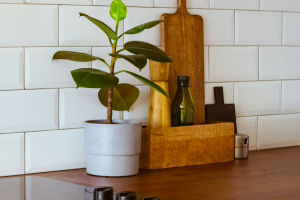Welcome, Lykkers! Aromatic plants can truly enrich the flavors of any dish, and rosemary is no exception. With autumn arriving, it's a great time to explore how to grow rosemary in a pot.
In this guide, we'll walk you through all the necessary steps to ensure your rosemary thrives indoors, providing beauty and flavor throughout the seasons.
How to Grow Rosemary in a Pot?
Choosing the Right Pot and Location
To start, choosing the perfect pot and location for rosemary is essential for its health. Rosemary is a hardy plant that does well in containers. When selecting a pot, make sure it has good drainage to prevent waterlogging.
A medium-sized pot is ideal, allowing enough space for the roots to grow. As for the location, rosemary thrives in a sunny spot. Place your pot near a window where it can receive plenty of sunlight. Direct sunlight is necessary for the plant to develop a strong aroma and vibrant leaves. Avoid placing it near heat sources, which can dry it out.
Planting Rosemary from Seeds or Cuttings
Rosemary can be grown either from seeds or cuttings. Both methods work well for growing in a pot, though planting by cutting is faster and often more reliable. If you are starting from seeds, the best time to sow them is in early spring, on a sunny day when temperatures begin to rise.
Sprinkle the seeds lightly on the surface of the soil and cover them with a thin layer of soil. Keep the soil moist and warm for the first two weeks, and you should start to see the first signs of germination.
For cuttings, it’s best to take a stem from a mature rosemary plant and plant it in the same type of soil, ensuring it stays moist until roots begin to form.
Watering and Care for Rosemary in a Pot
Proper Watering
Watering is a crucial factor in rosemary care. In the warmer months, rosemary needs more water as the temperature increases. However, in autumn and winter, it's essential to water less frequently.
The soil should remain slightly moist, but it’s important to allow it to dry out between waterings. Overwatering can lead to root rot, so always check the soil’s moisture level before watering. If the top layer feels dry to the touch, it’s time to water.
For the first few weeks after planting, rosemary needs more attention, as it is still establishing itself in the pot. After that, it will become more drought-tolerant and require less frequent watering.
Ensuring Proper Drainage
In addition to watering correctly, ensure that the pot has good drainage. Rosemary does not like sitting in waterlogged soil, so adding a layer of stones or pebbles at the bottom of the pot can help with drainage. This will allow excess water to escape, preventing the roots from becoming too wet.
Feeding and Fertilizing Rosemary
How to Fertilize Rosemary in a Pot?
Rosemary plants in pots have limited access to nutrients because their roots can’t spread as far as they would in the ground. To ensure your rosemary remains healthy, provide it with a balanced, liquid fertilizer designed for herbs.
This will give the plant the nutrients it needs to grow strong without overfeeding it. Follow the instructions on the fertilizer package carefully, as rosemary doesn’t require much feeding. Over-fertilizing can lead to weak growth and an overly lush plant that lacks the typical strong aroma.
Improving Soil Quality
If you feel the soil is losing its richness, you can top it with a layer of fresh, nutrient-rich compost. This will help provide a steady supply of essential nutrients to your rosemary plant throughout its growing season.
Pruning and Maintenance
When to Prune Rosemary?
The best time to prune rosemary is during the spring when the plant is actively growing. Pruning in spring encourages new growth and helps the plant maintain a compact, bushy shape.
As rosemary begins to flower in spring, this is a perfect opportunity to take cuttings if you wish to propagate the plant further.
When pruning, remove any dead or damaged stems, as these will not regenerate. For healthy stems, trim them back by about 7 to 8 cm, leaving enough leaves to prevent the plant from becoming too bare. This will help your rosemary remain vibrant and productive.
Dealing with Dead Stems and Flowers
As rosemary flowers, some stems may die off, especially during the colder months. Be sure to remove any dead growth to prevent the plant from becoming too congested. This helps improve airflow and ensures the plant continues to thrive.
Final Thoughts
Growing rosemary in a pot is a rewarding and enjoyable experience, providing fragrant leaves to enhance your culinary creations. By following these simple tips, you can cultivate a healthy rosemary plant that will thrive through the seasons. With the right care, rosemary can bring beauty and flavor to your home all year long. Enjoy your gardening journey, Lykkers!


